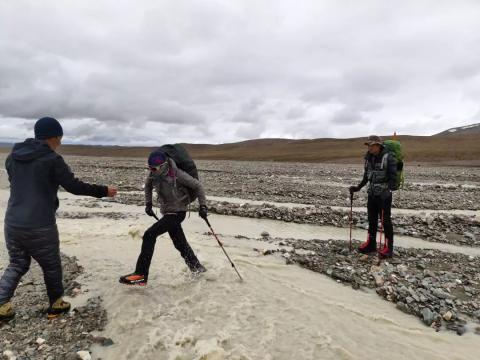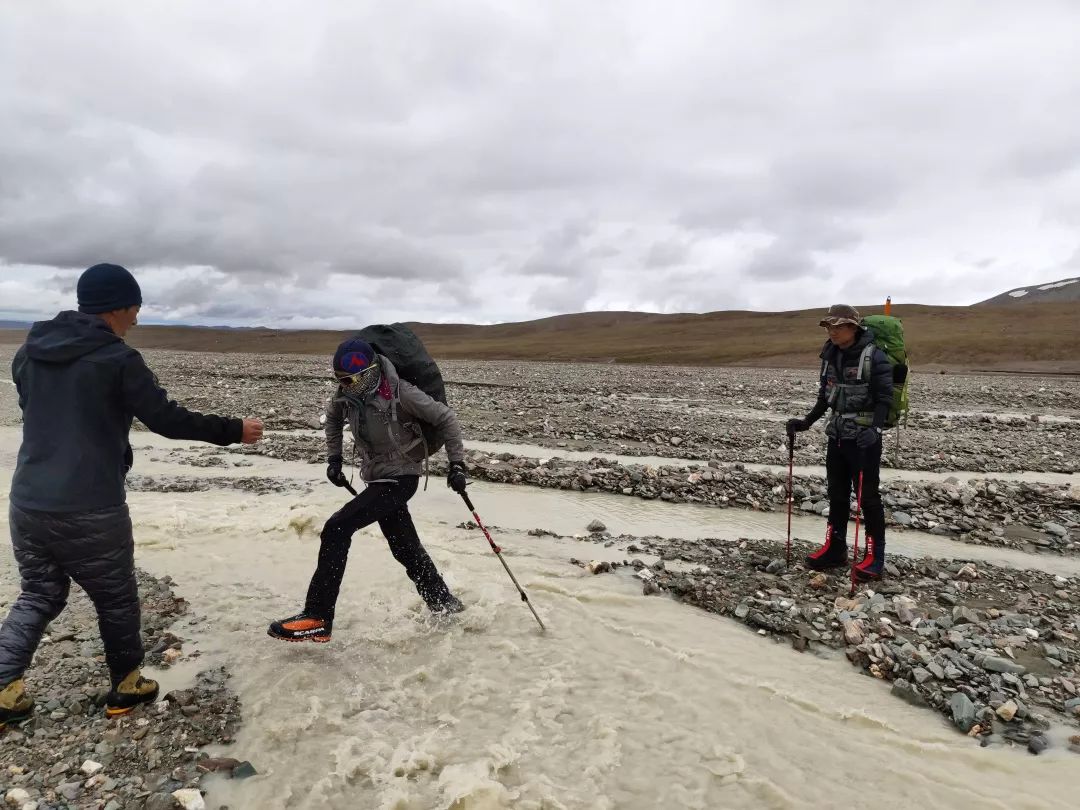
Pre-departure training

Climbing at high altitudes for a long time, with high loads and thin air requires your body and mind to be at a higher level than usual to be able to cope with it with ease.
1. Physical training - If you sit in an office or at a desk for a long time, you should take action and develop a physical training plan at least 6 weeks before climbing.
How much physical fitness is required to climb a beginner snow mountain? If you can complete a weekend hiking route with a distance of 20 kilometers and a climb of 2,000 meters (in an area below 1,000 meters above sea level) within 8 hours, such a body will be enough to cope with an entry-level snow mountain of 5,000 meters. Endurance training should be combined with strength training.
In order to ensure my physical fitness, I conducted intensive training for half a year. On average, I run about 70 kilometers per month and complete a full marathon; I go to the gym once a week and can do 20 standard pull-ups at one time. Before setting off, I thought I had plenty of energy, but was severely beaten in the face by the high altitude. During the early morning summit push, I was exhausted and walking slowly. I was the second to last person to climb Mount Yuzhu.
2. Skill training - Basic operation of technical equipment, and techniques such as slip braking are necessary in high mountains. If you purchase your own technical equipment such as ice axes, main locks, and descenders, bringing them with you and using them skillfully will be of great benefit to your successful climbing.
If time permits and the internal and external software and hardware are passed, you are already halfway successful. The next step is to choose the mountain you want to climb.
Determine the target

Mountain peaks are graded in difficulty. The first snow peak should start from the easy one and work your way up step by step.
1. Act according to your ability - It is a good choice to start with a snow peak with no technical sections, such as the big and second peaks of Siguniang Mountain, and a more difficult one, such as Haba Snow Mountain in Yunnan, Qinghai Mount Yuzhu.
Technical snow peaks will only make you feel overwhelmed and weak, causing you to descend early and end up hastily.
Changes in climate and policy can influence mountain selection. The original goal of this climb was the 5588-meter Nama Peak. However, there was too much snow on Nama Peak in July and August this year, and the snow was too deep to walk on, so it was temporarily changed to the 6282-meter Animaqing. Two weeks before departure, Animaqing was prohibited from climbing due to environmental protection reasons in Sanjiangyuan. The team members could only change their itinerary again and rush to Mount Yuzhu in Golmud, Qinghai.
2. Hire a guide - Hire a reliable guide and cooperate with you for your first climb. This will not only greatly increase the success rate, but also effectively improve learning. The team climbing Mount Yuzhu was spontaneously formed by alumni of the University of Science and Technology of China. It is non-commercial profit-making. However, we invited an experienced outdoor teacher with international professional qualifications and a senior outdoor instructor of the China Mountaineering Association as the team leader. He provided advice and escort for this climbing activity. After all, the leader’s girlfriend was also on the team.
3. Climbing Permit - Mountain peaks in my country are national assets. Before climbing, you need to contact the relevant departments to obtain a snow mountain climbing permit. The individual application procedures are very complicated, but joining a business team or outdoor association can easily solve this problem.
In addition, do not log in secretly. This behavior will bring you a lot of trouble and even danger. In order to avoid inspection, you may enter some dangerous and unknown areas.
4. Make itinerary - Select your own climbing route and action schedule by consulting the mountain information. Even if the team leader has arrangements, you should be aware of them.
For example, you should at least know the total length of the route, where there are campsites where you can rest, how much elevation you will climb, etc.
If you have chosen a mountain, made a good plan, and everything is ready, then you are 60% successful. When you set out to a plateau, the air becomes thinner, the oxygen content drops, and you need to adapt to the altitude.
Adapt to altitude

At an altitude of 4,500 meters, the oxygen content is only 58% of that at sea level, and the boiling point is about 85°C; at an altitude of 6,000 meters, the oxygen content is only 48%, and the boiling point is about 80°C. The significant change brought about by high altitude is the decrease in air pressure, for which you need to adapt to your diet and sleep.
1. Sufficient adaptation time - You should arrive at the base camp at the foot of the mountain as early as possible to provide your body with sufficient time to adapt to the altitude. We stayed at Xidatan in Qinghai (4200 meters) and Mount Yuzhu Base Camp (5100 meters) for two days each to ensure that the symptoms of altitude sickness were minimized.
2. Simple cooking——The air pressure decreases and the boiling point of water decreases, making it difficult to cook food. Eating it can easily cause gastrointestinal discomfort, thus affecting climbing. For every 5°C decrease in boiling point, it takes twice as long to cook food. Therefore, do not bring food that is particularly difficult to cook, such as uncooked rice and raw meat.
Carry foods that can be easily cooked and do not require sustained high temperatures, such as dehydrated foods, which are already cooked.
3. Eat the food you like - On the basis of what you have just said, you should choose food that you can eat. Do not prepare some nutritious but mediocre food just because it is a high altitude. Because you may not be able to swallow it at all then.
4. It is normal to not be able to sleep - At altitudes above 4,000 meters, the quality of sleep will drop significantly, even for aborigines. It is a normal physiological reaction to stay awake all night. You do not need to be anxious about it or worry about gains and losses. Even if you lie down in your tent all day long, make sure you drink at least three liters of water every day. "Drinking more hot water" is an effective way to relieve hypersensitivity and improve sleep quality.
Now that you have adapted to sleeping and eating at high altitude, congratulations, you have achieved 80% success. The next step is to reach the summit.
rational action

Snow mountain climbing is by no means as simple as heading up. You need to pay more attention to the walking rhythm than when hiking, and at the same time adhere to the schedule more strictly.
1. Get up early and set off - If conditions permit, don’t stay in bed. The earlier you set off, the better. When we reached the summit of Mount Yuzhu, we got up at two o'clock in the morning. The advantage of starting early is that after a whole cold night, the ice and snow are frozen hard, allowing you to walk faster and leaving plenty of daylight time.
2. Slow walking rhythm - Air pressure decreases, oxygen content decreases, and human body functions decrease accordingly. If you continue to walk at a fast walking rhythm on the plains, you will be very tired and it is easy to get high.
When climbing, your walking pace should be consciously slowed down, no matter how fast or violent you are on the plains. At the same time, you need to communicate frankly with your teammates and move at a speed you can accept. Forcibly accelerating for the sake of face will only lead to failure.
3. Reasonable rest - When hiking, we can rest at any time when we are tired, but in the process of climbing snow-capped mountains, every rest means the passage of precious time and the continuous decline of body functions.
Therefore, you should try to avoid stopping and taking long breaks when climbing. If you rest for ten minutes an hour, it is better to learn to rest sixty times an hour, each time for ten seconds, so that your heart rate can always be controlled at a low frequency.
4. Closing time - When climbing a mountain peak, you need to reach the top within a certain period of time starting from the summit. If you exceed this time, you must turn back and descend unconditionally no matter how close you are to the top. The Everest disaster in 1996 was the tragic consequence of not following the closing time.
The closing time of 5,000-meter primary snow-capped mountains is generally around noon, such as Siguniang and Sanfeng. The general summit climbing time is about 7 hours, and the closing time is 12 noon. The 6,000-meter Yuzhu Peak is not difficult to climb. Our team all reached the summit at 10 a.m. and had plenty of time to descend.
write at the end

When we climb a snow-capped mountain, we can gain an irreplaceable sense of vastness and sublimity. When we return to the foot of the mountain, we will love life even more. The mountains are long and the water is wide, the sky is high and the sky is high. Mountain climbing can lift a person to a new height in a physical way, making people feel cheerful and spiritually sublimated.
Climbing a snow-capped mountain is different from weekend camping. The risks are relatively higher and it is a more serious sport. Therefore, it requires full and thorough preparation and must not be rushed into the battle in a moment of enthusiasm. At the same time, you must act within your ability. There are many uncertain factors in climbing a snow-capped mountain. You may have to descend due to weather, supplies, etc. when you are only a few hundred or tens of meters away from the summit. At this time, it is better to let go of your obsession with climbing to the top. Giving up is part of mountain climbing, and shortcomings are the most loyal companions in life.
